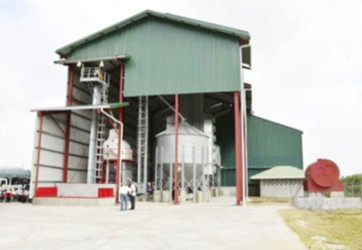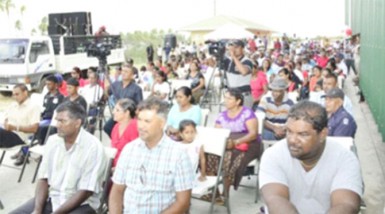President Donald Ramotar on Tuesday joined Minister of Agriculture Dr Leslie Ramsammy, officials from the Guyana Rice Development Board (GRDB) and the Rice Producers Association (RPA) to commission the modern $70M rice seed facility in Number 56 Village.
“It gives me great pleasure to be here to commission this plant which will make a contribution to our country and also to Region Six,” the president said in his address. According to Ramotar, his administration has invested heavily in the rice industry, particularly in research which has resulted in increased production, a report from the Government Information Agency (GINA) said.

“Over the years, we have been investing heavily in the different kinds of infrastructure, the work we are doing in research, I want to congratulate the scientists… in 1990 the rice industry was reduced to producing only 90,000 tons of rice a year and we were importing rice,” he said. “Now we have reached the stage where we are producing enough. Farmers must be congratulated… why we have been able to improve production is the fact that the government has been investing heavily in the industry over the years,” he reiterated.
According to the president, over the past 10 years his administration has invested over $45B on drainage and irrigation which can be considered one of the most important aspects of agriculture. Works in this endeavour were undertaken at Bengal, Rose Hall, Numbers 43 and 66 and several others villages where infrastructure such as pump stations were erected. While acknowledging these developments, Ramotar also spoke

of the challenges the industry has faced, particularly the price of paddy. “…We are price takers and we don’t determine rice prices and what we constantly do is look for higher pricing markets for our farmers,” he said, adding that it is for this reason that government is exploring other markets in Central America and Africa.
The president also spoke about government’s plan to put a mechanism in place for price support to rice farmers in the future. He also emphasised to farmers the importance of adding value to their products which all starts with the quality of seeds that are cultivated. Citing the soon to be commissioned rice cereal factory on the Essequibo Coast, Ramotar said his administration plans to undertake similar initiatives and is even looking at manufacturing of other products including rice flour.
Ramotar also hoped that more millers will move towards using the gasifier mechanism employed at a mill on the Essequibo Coast, in order to reduce costs. “For all of these plans to be a reality, we need good quality planting materials. The rice industry has a very bright future and its importance continues to grow,” the president said.
According to GINA, the seed cleaning facility was planned since 2004 and a design agreed upon in 2011. However, after some hiccups with the contractor, the GRDB stepped in and completed the facility.




